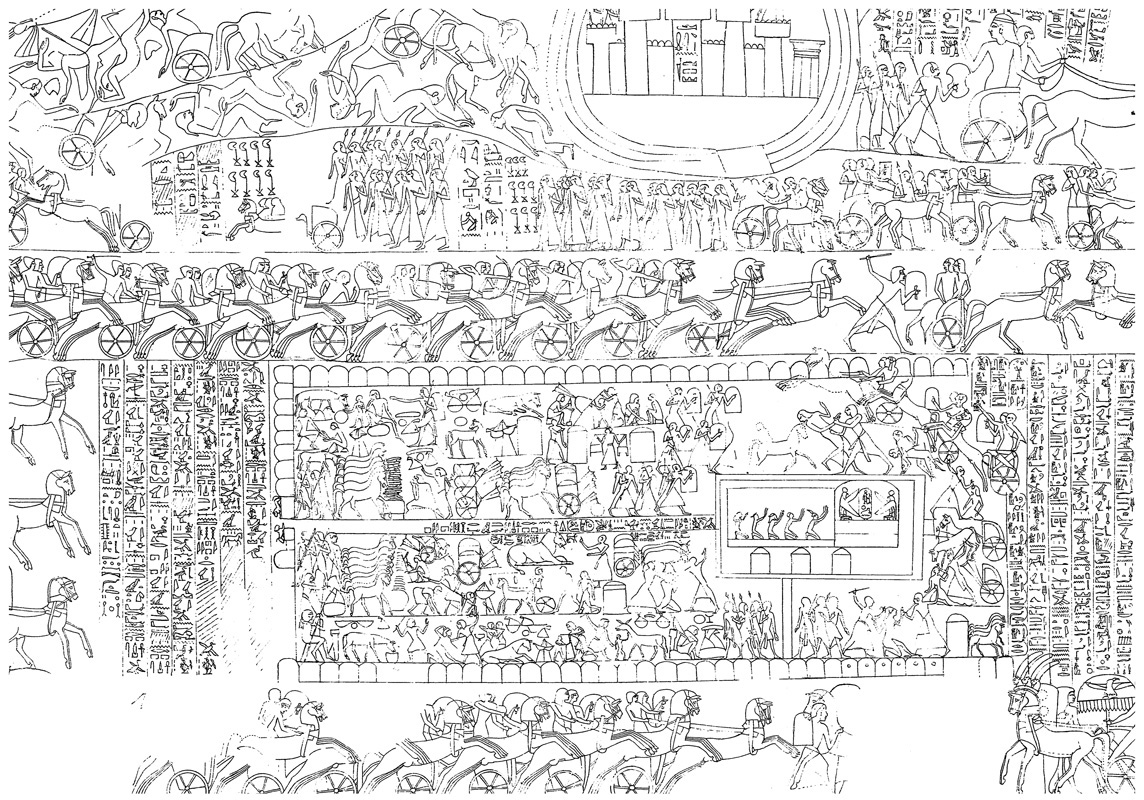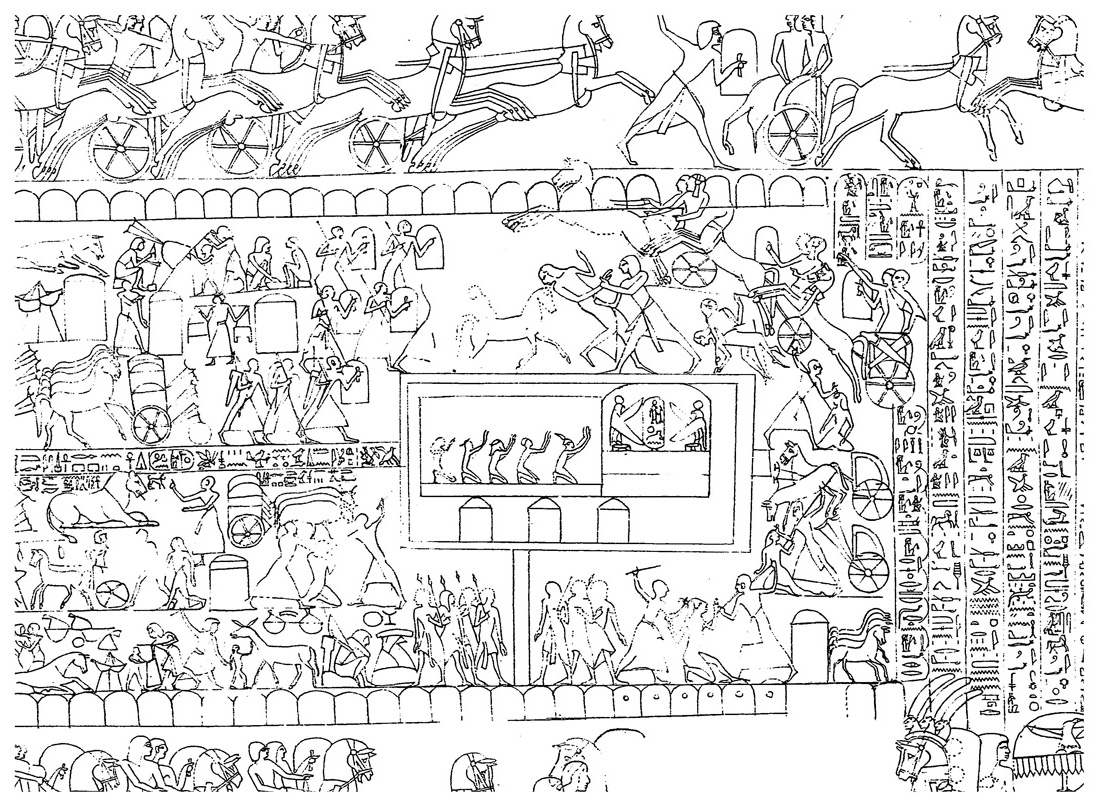i came across in an otherwise astounding article on the Exodus, which you can read here
[excerpt...] "Enter now a longstanding biblical conundrum. Scholars had long searched for a model, a precursor, that could have inspired the design of the Tabernacle that served as the cultic center of the Israelites’ encampment in the wilderness, a design laid out in exquisite verbal detail in Exodus 25-29. Although the remains of Phoenician temples reveal a floor plan remarkably like that of Solomon’s temple (built, as it happens, with the extensive assistance of a Phoenician king), no known cultic site from the ancient Near East seemed to resemble the desert Tabernacle. Then, some 80 years ago, an unexpected affinity was noticed between the biblical descriptions of the Tabernacle and the illustrations of Ramesses’ camp at Kadesh in several bas reliefs.
"In the image below of the Kadesh battle, the walled military camp occupies the large rectangular space in the relief’s lower half (click on image to enlarge):

The throne tent of Ramesses II with winged falcons flanking his cartouche at Abu Simbel. W. Wreszinski, Atlas zur altägyptischen Kulturgeschichte Vol. II (1935), pl. 169.
"The camp is twice as long as it is wide. The entrance to it is in the middle of the eastern wall, on the left. (In Egyptian illustrations, east is left, west is right.) At the center of the camp, down a long corridor, lies the entrance to a 3:1 rectangular tent. This tent contains two sections: a 2:1 reception tent, with figures kneeling in adoration, and, leading westward (right) from it, a domed square space that is the throne tent of the pharaoh.
"All of these proportions are reflected in the prescriptions for the Tabernacle and its surrounding camp in Exodus 25-27, as the two diagrams below make clear:
"In the throne tent, displayed in tighter focus below, the emblem bearing the pharaoh’s name and symbolizing his power is flanked by falcons symbolizing the god Horus, with their wings spread in protection over him (click on image to enlarge):
"In Exodus (25:20), the ark of the Tabernacle is similarly flanked by two winged cherubim, whose wings hover protectively over it. To complete the parallel, Egypt’s four army divisions at Kadesh would have camped on the four sides of Ramesses’ battle compound; the book of Numbers (2) states that the tribes of Israel camped on the four sides of the Tabernacle compound.
"The resemblance of the military camp at Kadesh to the Tabernacle goes beyond architecture; it is conceptual as well. For Egyptians, Ramesses was both a military leader and a divinity. In the Torah, God is likewise a divinity, obviously, but also Israel’s leader in battle (see Numbers 10:35-36). The tent of God the divine warrior parallels the tent of the pharaoh, the living Egyptian god, poised for battle.
"What have scholars made of this observation? All agree that no visual image known to us from the ancient record so closely resembles the Tabernacle as does the Ramesses throne tent. Nor is there any textual description of a cultic tent or throne tent in a military camp that matches these dimensions. On this basis, some scholars have indeed suggested that the bas reliefs of the Kadesh inscriptions inspired the Tabernacle design found in Exodus 25-27. In their thinking, the Israelites reworked the throne tent ideologically, with God displacing Ramesses the Great as the most powerful force of the time.
"(For the Torah, of course, God cannot be represented in an image and requires no protection, and pagan deities have no standing, which is why, instead of falcons and Horus, we have cherubim hovering protectively over the ark bearing the tablets of His covenant with Israel.) Others suspect that the image of the throne tent initially became absorbed within Israelite culture in ways that we cannot trace and was later incorporated into the text described in Exodus, but with no conscious memory of Ramesses II. Still others remain skeptical, considering the similarities to be merely coincidental. [...]"


6 comments:
They speculate that the direction of influence is Egypt to Israel. And that's most of what they do, is speculate. They are very light on facts and truth.
What if the influence was the other way around? First came the mishkan, then the "throne tent."
Interesting insight. But how could that be? When the Exodus came first, the trek into the Sinai, and then receiving our Torah instructions; in that order? Another thought: We say hamotzi on Wheat Challah, all these years after the experience of 'bread' in Mitzrayim. They were known as experts in baking and cultivating all sorts of bread variations. I believe the Israelites ate pitot and maybe only learned to 'leaven their bread from the mitzrayim. Also, I believe I read on jewishhome.news that a semitic (arabic) tribe called Hyksos actually ruled during the "Yosef era". And after all the sons of Yaakov passed on, did the actual Egyptians come to power and that with them the persecution and slavery of both the leftover Hyksos and Israelites. And it was those persecuted Hyksos (semites) with some (maybe) egyptians that made up what later were called the "erev rav". See "The Hidden History of Yosef and the Pharaohs who were not Egyptians" at jewishhome.news.
I can agree with Shimshon's view point. Something as holy as the Tabernacle
would not be a copy of an Egyptian structure. We have to remind ourselves that the building of the Tabernacle and its vessels are all from Hashem.
That is why it's good to ignore any information taken from non Jewish sources when it comes to Torah.
That's why I don't understand why Jews take info from Wikipedia, etc.
Yiddel
Only the secular Egyptologists speculate that the Exodus occured during the time of Ramesses II. Most Jewish and other non-secular Egyptologists staunchly disagree and say it happened much earlier
YY
It is far more likely that Amenhotep ii was Pharaoh of the Exodus
YY
Thank you all. It was incongruous and needed watchful commenters to assess what they thought. Regardless of what the archaeologists et al, find or conclude, we hold fast to what our Torah describes and our Sages tell us. I just finished reading a fascinating book about life under the harshness of Mitzrayim, called THE LAST SLAVE. I chose it to empathize with the generations of Yaakov. And to feel as if one was there. It described very graphically what the slaves (families) went thru (most of the pages), the finally arrival of Moshe Rabbeinu and their redemption. I did so to compare what we are going thru under this latter day ‘Egyptian Erev Rav, and the psychological war we are in.
Post a Comment